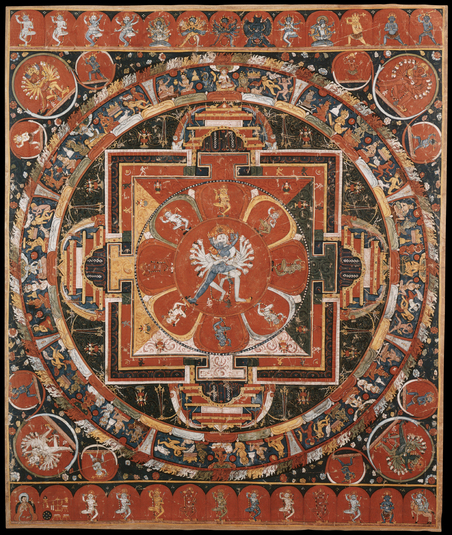
Item: Mandala of Hevajra (Buddhist Deity) - (Hevajra Tantra)
| Origin Location | Tibet |
|---|---|
| Date Range | 1300 - 1399 |
| Lineages | Sakya and Buddhist |
| Material | Ground Mineral Pigment on Cotton |
| Collection | Private |
Hevajra Nine Deity Mandala.
Unique Features of the Painting: - How to date the painting. - Damage & restoration. - Identifiable eight siddha figures. - Dakini Blessings circles. - Panjara Mahakala without a gandhi staff.
The upper left corner has been damaged or lost and a number of the figures have been replaced and possibly with the cloth. An inspection of the back would be required to do a full assessment of the repair and restoration. From the top register on the left side the first three deities are replacements and not iconographically correct. The Ratnasambhava-Hevajra immediately below the upper register is also restored along with the white and blue figures to the right and left.
The identifiable figures in the top register from left to right are the Three-faced Hevajra, Akshobhyavajra Guhyasamaja, Kalachakra, Chakrasamvara, Ekavira Vajrabhairava, Mahamaya, and Yogambara. The preceding figures are all meditational deities of the fourth classification of Tantra. The remaining figures are yellow Ushnisha Chakravartin, blue Humkara and blue Niladanda. Those three deities belong to the Protection Wheel circle of deities unique to the Hevajra Tantra system. The other ten protection deities are placed in circles surrounding the mandala between the figures of the Five Buddha Family Hevajra deities: yellow Ratnasambhava-Hevajra, red Amitabha, green Amoghasiddhi and white Vairochana.
The iconographic composition of the painting, particularly the top register with the row of mostly unrelated meditational deities, does not feel complete in itself. It is likely that the painting belongs to a larger set with selected mandalas as the main subject and the upper and possibly lower registers depicting the Vajravali cycle of practices. This would be more probable if the painting originated from Shalu, Jonang, Bodong or Sakya monastery.
In the circle of eight cemeteries surrounding the square central palace of Hevajra are eight siddhas. Starting at the top center is Virupa, and moving to the right is Luipa, Kukkuripa, Saraha, Indrabhuti, Dombi Heruka, Nagarjuna, and Ghantapa. In front of each siddha and slightly above is a red circle containing a pair of hands or a hand holding a skullcup. This early iconographic convention represents the direct blessings of the dakinis being received by the siddhas. This artistic consideration is rarely followed after the 14th century and completely disappears by the beginning of the 16th century, if not earlier.
At the bottom left corner is a donor supplicant seated in front of a shrine. Along the bottom of the register are the nine goddesses of the senses and body, speech and mind. At the bottom left corner are the principal Sakya protector deities Panjara Mahakala and Shri Devi riding a donkey. It is noteworthy that Panjara is not holding the typical gandhi staff across the forearms along with the curved knife and skullcup. This would indicate that the artist is purposely depicting the form of Mahakala from the 18th chapter of the Vajrapanjara Tantra where the gandhi staff is not included as part of the iconography of the deity.
Jeff Watt, 2-2021
Indian Adept: Hands of the Dakini/Deity
Mandala: Sakya Masterworks
Buddhist Deity: Hevajra Main Page
Buddhist Deity: Hevajra Mandalas
Painting Set: Vajravali Mandalas (Sakya Tradition)

